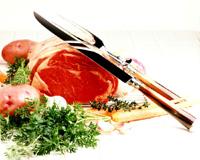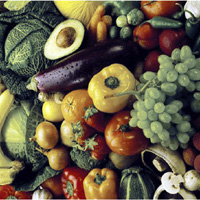Originally published in November-December 2004 icon
One Man’s Meat...
by Ginny Fraser
"I believed that no two people on the face of the earth were alike; no two people have the same fingerprints, lip prints or voice prints. No two blades of grass or snowflakes are alike. Because I felt that all people were different from one another, I did not think it was logical that they should eat the same foods. It became clear to me that since each person was housed in a special body with different strengths, weaknesses and nutritional requirements, the only way to maintain health or cure illnesses was to accommodate to that particular patient’s specific needs."

Generally, cancer diets recommend a vegan / vegetarian approach

These words, spoken by American naturopathic doctor James D’Adamo, inspired his son Peter to develop and promote The Blood Type diet, which burst onto the US diet scene in the mid-nineties with an almost Atkins style following. D’Adamo’s first book "Eat Right for Your Type" still features prominently in high street bookshops, and just published this year is "Cancer. Fight it with the Blood Type Diet".
Generally, cancer diets recommend a vegan / vegetarian approach. Indeed, some cancer therapies such as Gerson are based on the banishing all animal proteins. The Oxford Study on vegetarians showed that they have 40% less cancer risk than non-vegetarians. Vegetarians are PC, taking care of their health and the planet, while meat eaters are on a one-way trip to blocked arteries and high blood pressure. Or so goes the conventional wisdom.
The problem, as D’Adamo saw it, was that although some people thrived on a veggie regime, others patently did not. A bit like the way some weight-loss programs seem to work for one person and not another. His Blood Type Diet was his answer to this paradox.

Even today, the most prevalent blood group is O

It is based on the idea that the different blood types evolved at different times in Man’s history and thus have different pre-dispositions in the type of food that is suited to their make-up. For example, he claims that from the early Neanderthal of c. 50,000 BC the blood group of these peoples was Type O. Their diet was that of the hunter-gatherer - roots and plants and animal prey. Even today, the most prevalent blood group is O.
As the human raced moved around the world and adapted its diet to changing conditions, a different diet provoked changes in the digestive tract and immune system to help us survive in the new environments. These changes are reflected in the development of the blood types. For example, as the human race shifted from hunter-gatherers to a more agrarian lifestyle Type A appeared - initially somewhere in Asia or the Middle East around 25,000 BC - 15,000 BC. Type A is found in its highest concentration among Western Europeans.
As the races merged and migrated from the Africa to Europe, Asia and the Americas, Type B evolved around 10,000 BC. Type B is found in high numbers in Japan, China and India. Last of all, came Type AB as migration accelerated and the As and Bs mixed, and is the "newest" of blood types
According to D’Adamo, blood type plays a huge role in determining who gets cancer and who doesn’t, also which cancer is more likely to occur in which blood group, as well as the survival rate of cancer patients. This is because blood group is integral to the strength and health of the immune system.
Our immune system detects foreign substances in the body. One way it does this is by looking for antigens, found in the cells of our bodies and most other living things. If an antigen is recognised as "self", it is welcome, but if it is found to be "non-self", it is designated an intruder and dealt with accordingly, by the white blood cells.

Blood type plays a huge role in determining who gets cancer and who doesn’t

Your blood type carries an antigen, so when your immune system is patrolling for suspicious characters, one thing it looks for is whether a suspect in question has any similarity to your blood type antigen. All of us, except AB, carry antibodies that reject the antigens of the other blood types - which is why mismatched blood transfusions typically lead to death.
What has all this got to do with cancer? According to D’Adamo, there are a number of reasons why blood type is highly relevant. First, it is important that cells of the body stay differentiated - ie that a muscle cell stays a muscle cell and that a fingernail cell stays a fingernail cell. The body goes to great trouble to keep the cells differentiated, to prevent the cell anarchy that leads to cancer. Blood type antigens are closely involved in differentiation.
Another aspect is that many malignant cells develop a tumour marker called Thomsen-Friedenreich (T) antigen, which has a structural similarity to the A antigen. This is normally suppressed in a healthy cell, but becomes evident as the cell moves toward malignancy. Therefore many tumours have markers which are undetectable by those with Blood Type A and AB immune systems.
According to D’Adamo, "there is undeniable evidence that people with A or AB blood have a higher rate of cancer." However, there is also research that shows a consistent link between Type O and melanoma, and Type B with bone cancer, so Os and Bs shouldn’t get too complacent!
The risk of cancer is also influenced by two other factors: secretor status and the MN blood typing system (a minor blood grouping system). If you are a "secretor" then you secrete blood type antigens into your body fluids like saliva and mucus. Around 80% of the population are secretors. The rest - the non-secretors - are generally far more likely to suffer from immune diseases, but are less likely to have cancer. The MN system also plays a minor role in that type MM has a higher risk of cancer over MN and NN types.

Around 80% of the population are secretors

By now you may be reeling with information. Many of us don’t know our blood group, let alone our secretor or MN status! As these are tests that are not commonly available, naturopath Tom Greenfield has a clinic in Canterbury, where he treats patients with the Blood Type Diet and also provides a mail-order lab where patients can get this information.
Where does food come in? There is a chemical reaction between your blood type antigen and the foods we eat. Minimising foods that detract from proper immune function is clearly a wise move for people with cancer. Many of these "unsuitable" foods tie up the immune system unnecessarily by interacting with your opposing blood type antibodies. This is because the proteins in food also have antigens which are similar to the blood type antigens. If you eat food that contains foreign blood type antigens that will trigger your anti-blood type antibodies and the result is the agglutination (sticking together) of cells. Agglutinins in food are called lectins, and are specific to one blood type of another. Some lectins might be damaging for one blood type, yet have little effect on another. There are some lectins, shown below, that have proved to be particularly good for different blood types.
Peanut - A, AB; Soy bean - A, AB; Broad bean - all types; Mushrooms - all types; Amaranth - A, AB; Jackfruit - all types.

What should someone with cancer eat?

The second significant use of blood-type specific lectins is their ability to agglutinate malignant cells.
So, what should someone with cancer (or hoping to prevent it) eat? Although much more detail is available in the many D’Adamo publications, below is a summary of each type, including a short personality profile and exercise preferences with each type’s "superfood" also included. It is interesting to note how the profiles compare to the origins of the blood groups described earlier

Type O
Cancer-fighting superfoods: broad bean, oily fish, seaweed, walnut, mushroom
Eat: Red meat, fish, vegetables, fruits, green tea
Avoid: Most grains (amaranth, quinoa); most dairy
Curious fact: club soda is beneficial for Os
Exercise: high-intensity, aerobic
Personality type: strong, self-reliant, daring, intuitive, optimistic

Type A
Cancer-fighting superfoods: soya foods, oily fish, snail, flax oil, peanut
Eat: Fish, vegetables, fruits, dairy in small quantities, grains
Avoid: most meat (though chicken can be eaten), potatoes
Curious fact: red wine and coffee are both permitted for As!
Exercise: regular, calming such as Hatha yoga, Tai Chi, light aerobic
Personality type: co-operative, sensitive, passionate and self-controlled

Type B
Cancer-fighting superfoods: yoghurt, cultured dairy foods, ghee, oily fish, flax oil, walnuts, vegetables, fruit
Eat: Most flesh foods, turkey, fish, dairy, grains
Avoid: Chicken, soy products
Curious fact: club soda should be avoided by Bs
Exercise: mixed aerobic and stress-reducing
Personality type: the best of the Os and As, balanced, flexible, creative

Type AB
Cancer-fighting superfoods: oily fish, snail, soy foods, cultured dairy foods, vegetables, fruit
Eat: A limited amount of flesh foods, oily fish, most dairy, olive oil,
Avoid: Chicken, beef, butter
Curious fact: ABs should avoid Worcester sauce
Exercise: mixed aerobic and calming
Personality type: spiritual, relaxed, forgiving, charismatic
Tom Greenfield has been recommending the Blood Type Diet for over seven years and has seen what he describes as "incredible" results for those willing to change their eating patterns. "The most radical results have been with those in blood group O who have previously been vegetarian," he states. "Although this doesn’t match the conventional diet advice, it seems that meat doesn’t create as much acid in Os as grains do. The Os seem to do better on slightly acid side." Greenfield’s work also bears out D’Adamo’s claim that Type A women are over-represented among breast cancer patients, and especially those with MM status, in addition to all the normal risk factors such as heredity.
Greenfield points out that the Gerson Therapy was perfectly designed for the majority of people who get cancer - the Type As. However, not quite everything fits. Michael Gearing-Tosh, author of well-know cancer autobiography, Living Proof, who was a Gerson aficionado checked out D’Adamo’s work and, as an A, excluded potatoes from his regime, to good effect.
There are also a number of supplements specific to blood types, but generally seen to be useful with cancer. These include Helix Plus, which may be particularly welcomed by those blood types recommended to eat snail as it contains the snail lectin! Quercitin and Larch are also highly recommended.

There are so many diets to choose from and every one of them will be inadequate for someone

While the blood type diet provides a neat and simple formula, the jury is still out about how effective it is for cancer patients. It certainly doesn’t have the scientific pedigree or rigour of Metabolic Typing. Dr Patrick Kingsley, Leicestershire-based cancer specialist agrees there is "a certain logic to it", but warns against one system being right for everyone. "There are so many diets to choose from - from the Stone Age diet to the Vega-tested diets - and every one of them will be inadequate for someone." Likewise, Dr Fritz Schellander, who practises in Tunbridge Wells, has some reservations and some questions about the evidence behind some of the extensive and very specific food protocols D’Adamo recommends. "Any dietary programme has to be safe, affordable and evidence-based. While this programme meets the first two criteria, I would be interested in HOW they came about their evidence for each of the foods recommended."
A register of UK-based D’Adamo-friendly doctors is available on the website www.dadamo.com.
Tom Greenfield’s lab services are available on www.nature-cure.co.uk or by calling 01227 761000.